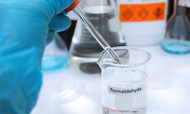What Should You Do if You’re Exposed to Formaldehyde?
20th Feb 2024
Formaldehyde, a common chemical found in many workplace settings, is known for its preserving qualities in products ranging from adhesives to textiles. It’s also a potent irritant and potential health hazard. Discover what you should do if you’re exposed to formaldehyde and critical tips for preventing workplace exposure.
Limit Your Exposure and Get to Safety
Your first and most important action if you suspect formaldehyde exposure is to move to a well-ventilated area. This limits your continued exposure and is a crucial step in preventing any more serious health effects. Whether you’ve inhaled, ingested, or been in skin contact with formaldehyde, move away from the source and get to fresh air.
If formaldehyde contamination is on your clothes, remove any affected items immediately to minimize the risk of skin irritation or burns. Removing contaminated clothing can prevent the chemical from being absorbed into your body through your skin, which could lead to more severe health complications. Wash contaminated clothing thoroughly before wearing it again.
Treat the Effects of Exposure
Currently, there isn’t a specific antidote for formaldehyde exposure, which means the focus of treatment should be on alleviating any symptoms you might experience. Acting promptly is crucial; if you believe you’ve been exposed to formaldehyde, take immediate action and seek medical assistance.
Skin Contact
If formaldehyde makes contact with your skin, immediately clean the affected area with soap and water for 15 to 20 minutes. If the skin develops a chemical burn, cover the affected area with dry, sterile dressings and seek medical attention.
Eye Exposure
If formaldehyde splashes into your eyes, flush your eyes with clean, low-pressure water for 15 to 20 minutes. Lift your eyelids periodically to let the water clean more of the surface area. If you wear contacts, remove them while flushing.
After flushing, do not rub your eyes, and do not put any eyedrops in your eyes unless instructed to do so by emergency personnel. If a chemical burn develops, loosely apply a dry sterile dressing and seek immediate medical care.
Inhalation and Ingestion
If you inhale formaldehyde, move to fresh air and seek medical attention immediately. Symptoms of exposure include coughing, wheezing, and a burning sensation in the throat.
If you ingest formaldehyde, seek medical attention immediately. Ingesting even a small amount of formaldehyde can be deadly. Formaldehyde ingestion may cause bleeding, vomiting, pain, and intestinal perforation.
Prevent Exposure
Proactive strategies to limit formaldehyde exposure in your workplace can greatly reduce health risks for you and your colleagues. Use a formaldehyde gas detector to monitor the air continuously. If the detector alerts workers to elevated formaldehyde levels, employees should immediately cease work, ventilate the area if possible, and follow established safety protocols for exposure prevention while personnel assess and secure the site.
Employees must wear OSHA-approved personal protective equipment (PPE) when working with formaldehyde, which may include:
- Splash-proof goggles
- Nitrile gloves
- Boots and aprons impervious to formaldehyde
- Respirators
If you are exposed to formaldehyde, you should promptly treat the affected area and distance yourself from the source to prevent further harm. Seeking immediate medical assistance ensures that you receive appropriate treatment and advice for managing any potential complications. Furthermore, use preventative strategies to limit exposure and safeguard health effectively.

